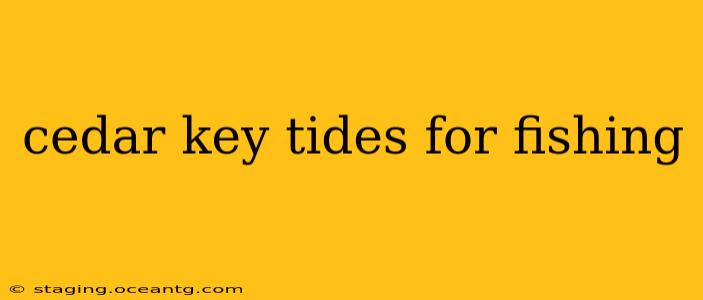Cedar Key, Florida, is a renowned fishing destination, boasting abundant marine life and a unique ecosystem. However, understanding the tides is crucial for maximizing your fishing success. The ebb and flow of the water significantly impact fish behavior, feeding patterns, and accessibility to prime fishing spots. This comprehensive guide will help you leverage the Cedar Key tides to improve your angling experience.
What are the best tides for fishing in Cedar Key?
The "best" tide for fishing in Cedar Key, or anywhere for that matter, isn't universally defined. It depends heavily on the species you're targeting and the fishing method you're employing. Generally, incoming tides are often preferred by many anglers. As the water rises, it pushes baitfish and smaller creatures closer to shore, attracting larger predatory fish that are easier to reach. The moving water also creates a more dynamic feeding environment. However, outgoing tides can be equally productive, especially for species that feed on exposed flats or during the outgoing current's pull.
How do I find the Cedar Key tide chart?
Numerous resources provide accurate tide predictions for Cedar Key. You can easily find these online through a simple search for "Cedar Key tide chart." Many websites and apps offer detailed predictions, including high and low tide times, water levels, and even sun and moon phases. Consider using a reputable source known for accurate weather and tide forecasting.
What is the difference between high tide and low tide fishing?
High tide fishing often means accessing areas normally submerged, offering opportunities to target fish closer to shore. Low tide, conversely, exposes shallow flats and oyster bars, making it ideal for wading or targeting species that prefer these habitats. The best time depends on your target species and location. For example, redfish often patrol shallow flats during low tide, while snook might be more active around docks and structure during high tide.
What are the ideal conditions for fishing in Cedar Key?
Besides the tide, other factors play a significant role in successful fishing. These include:
- Water clarity: Clear water allows fish to spot your bait or lure more easily, but murky water can also concentrate fish in certain areas.
- Weather conditions: Strong winds, storms, or extreme temperatures can negatively impact fishing. Calm, sunny days are generally ideal.
- Moon phase: Some anglers believe that the moon phase influences fish behavior, but its impact is still debated.
The combination of a favorable tide, good weather, and clear water creates optimal fishing conditions.
When is the best time of day to fish in Cedar Key?
The best time of day to fish in Cedar Key often coincides with periods of changing light. Sunrise and sunset are often prime times as fish become more active during these transitional periods. However, the best time can vary depending on the species and conditions.
How do I predict the best fishing times based on tides?
Predicting the best fishing times requires combining tide charts with your knowledge of fish behavior. Consider the target species’ preferred habitat and feeding patterns in relation to the tidal movements. For instance, if you're targeting redfish on the flats, you might focus your efforts during the outgoing tide when they're actively feeding on exposed prey.
By understanding the interplay of tides, weather, and fish behavior, you can significantly improve your chances of a successful fishing trip to Cedar Key. Remember that experience and local knowledge are invaluable assets, so consider talking to local anglers and guides for insider tips.
Disclaimer: This information is intended for general guidance only and should not be considered professional fishing advice. Always practice safe boating and fishing techniques, and be aware of local regulations and restrictions.
